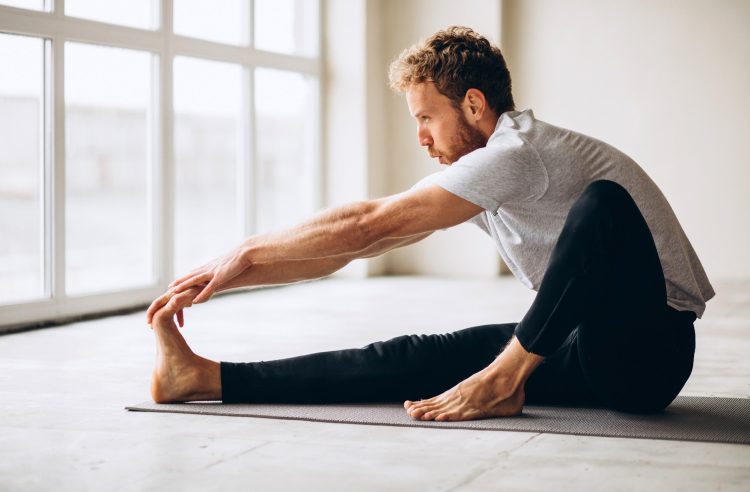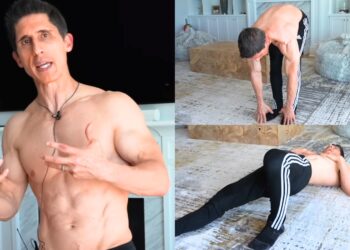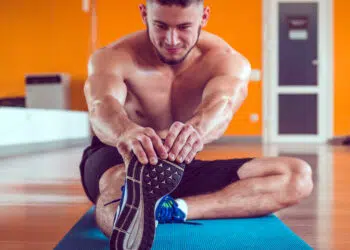Do you take a ‘go-hard or go-home’ approach to stretching and feel that since you never stretch, you must push your muscles to their limit when you finally do stretch? If the answer is yes, then you may want to make some changes to your stretching routine.
Stretching can significantly improve your range of motion and help you move better. (1) However, it is possible to overstretch, especially if you are taking an aggressive approach. Applying too much force while stretching can result in soreness and lower the effectiveness of the stretch.
In this article, we’ll dive into the consequences of overstretching, how it happens, and how to avoid it.
We’ll also review the best practices for stretching I’ve learned during my time as a physical therapist and strength and conditioning coach so that you can stay injury-free and optimize your range of motion.
What Is Overstretching?
Just as with regular strength training, injury occurs when tissue is pushed beyond the limits of its capacity. Most people may not consider stretching an activity that can cause injury, but when it comes down to it, stretching is a stressor, and too much stress can be harmful. (2)
Overstretching occurs when the muscle is lengthened aggressively beyond its current ability, creating acute soreness and discomfort.
Level Up Your Fitness: Join our 💪 strong community in Fitness Volt Newsletter. Get daily inspiration, expert-backed workouts, nutrition tips, the latest in strength sports, and the support you need to reach your goals. Subscribe for free!
Physiology Behind Overstretching & Tissue Strain
With any tissue stress, the tissue goes through a sequence of stages based on the force applied to it. This concept is called the tissue stress-strain curve and outlines the different happenings within the tissue as it is stressed. Below are the stages that occur as you apply a stretching force to the muscle:
Toe Region
Your muscle cells contain collagen fibers, which are crucial for providing strength and structural support. These collagen tissues possess a wavy or folded appearance at rest. When a force is applied to them, such as a stretching force, these wavy collagen fibers initially straighten out and cause the tissue to take up slack. (2)
This is kin to holding a loose rubber band and providing just enough tension so that the rubber goes from loose to taught.
Elastic Region
In the elastic region of tissue deformation, the tissue begins to deform linearly and expands in length as tension is applied. In this phase, the tissue is being stretched beyond simple tension; however, it does not approach a point where it cannot return to its resting length once the force is reduced or removed.
In the elastic phase, this would be like stretching the rubber band to the point where it is maximally stretched and recoils rapidly to its original state without any damage.
Plastic Region
The plastic region is the point on the stress-strain curve where overstretching may begin. At this point, so much force is being applied to the collagen fibers and muscle tissues that progressive failure and microtearing begin. At this stage, the tissues cannot return to their original shape once the load is removed.
Getting to this stage with voluntary stretching would likely become painful. Most people would not continue beyond this point outside of a stretching-related injury, such as during a sporting event.
Failure Region
The failure region is the point at which the tissue is disrupted, causing a rupture or fracture. It is highly unlikely that you would ever reach this point while stretching, but rapid muscle stretching can cause tearing, such as with bicep tendon or hamstring tears.
Overstretching during voluntary stretching routines is likely due to stretching practices that are too forceful or are held for longer than you are accustomed to rather than to the point of actual soft tissue injury.
Causes of Overstretching
You can progress through the stress-strain curve and potentially stretch too far in two ways. These include the magnitude of force you apply to the tissues and the duration you hold the force.
Force application is what most people assume causes injury. For example, most people would look to avoid rapidly and aggressively pushing into a stretching position because it would cause immediate feedback that this could cause harm.
But what may not be so obvious is that the duration you hold the stretch can also progress you through this stress-strain curve. Concerning muscle tissue, the plastic region where microscopic tears begin can happen anywhere between 30 seconds and two minutes or more.
If you have ever experienced soreness in the muscle you were stretching in the days following, then you likely approached this stage. A little bit of soreness is not a cause for concern, especially if you are just starting a stretching program. But if you have a significant amount of soreness, you likely overdid it.
Benefits of Consistent Stretching
Here are the advantages of making stretching a part of your fitness regime:
Improved Flexibility and Range of Motion
One of the most common benefits of consistent stretching is its effect on improving flexibility and range of motion. By performing a regular stretching routine, you can reduce your central nervous system’s resistance to stretch and stiffness in the body. (1)
Although regular stretching may not correlate with a reduction in injury for athletic or fitness populations, it can help reduce joint or muscle discomfort and improve mobility for everyday tasks.
Emphasizing soft tissue and joint range of motion can also prevent painful conditions such as impingements caused by improper joint motion and overuse of certain areas in the body because the joints around them do not move properly. (3)
Enhanced Athletic Performance
Stretching consistently can also improve athletic performance, especially if your performance depends on your ability to achieve certain positions. For instance, a weightlifter will need to achieve a deeper squat position to effectively receive the barbell during an Olympic lift.
Similarly, a gymnast needs flexibility in the hips, hamstrings, and shoulders during mat or pommel horse routines.
With regards to field or court athletes, flexibility and optimal joint range of motion can help athletes run at increased speeds. For instance, optimal hip extension during each stride is an important factor in maximal speed running. (4)
This is due to the impact that stiff hip flexors can have on the hip’s extension range of motion, and when the hip flexors become stiff, the stride is shortened, which can hamper running speed. (4)
Increased Blood Flow
After a workout, an influx of nutrient-rich blood can provide nutrients such as essential amino acids and carbohydrates to recover. It also helps remove metabolic waste that is generated with exercise. Consistent stretching has been shown to increase blood flow to the target muscles. (5)
Level Up Your Fitness: Join our 💪 strong community in Fitness Volt Newsletter. Get daily inspiration, expert-backed workouts, nutrition tips, the latest in strength sports, and the support you need to reach your goals. Subscribe for free!
Thus, when stretching is included in your exercise routine, it can assist you in recovering from training and preparing for the following session.
Increased Parasympathetic Tone & Relaxation
After periods of high stress, such as intense training, incorporating stretching into a cool-down routine can help shift you into a more parasympathetic state.
The parasympathetic state is the “rest and digest” state of the nervous system. Conversely, the sympathetic state is used during “fight or flight” situations where a response must be made quickly. In the gym, this would translate to lifting a heavy weight or performing intense conditioning.
Each of these states is important for survival. But after an intense activity, such as a tough session in the gym or a stressful work event, getting yourself into a more parasympathetic state can promote recovery. (6)
Stretching, combined with deep breathing techniques, can help stimulate an increased parasympathetic state. This can also improve cortisol levels, digestion, and sleep quality.
When To Avoid Stretching
This is when you should stay away from stretching:
Muscle Strains
You should avoid stretching altogether if you believe you have suffered a muscle strain or tear. In this case, you should seek help from a qualified healthcare professional. There is a grading system for muscle strains to determine the severity of the damage done.
- Grade 1: Minimal decrease in muscle function, with mild discomfort and localized pain (7)
- Grade 2: Weakness in the muscle due to a partial tear with moderate to severe pain and decreased range of motion. As well as swelling and bruising. (7)
- Grade 3: A full muscle tear and severe pain, bruising, and loss of muscle function. (7)
If you suffer a muscle strain, then you will likely incorporate stretching into your rehab plan at some point.
However, after the initial injury, aggressive stretching may impact the healing process and even cause more damage. In this case, you should avoid stretching and seek out a healthcare professional who will likely recommend a bout of rehab.
Joint Stability
Joint instability occurs when a joint cannot maintain a centralization of the bony anatomy during movement. This is often caused by a lack of motor control or strength of the muscles in the area that cross the joint and are supposed to provide stability as the joint moves.
In this instance, you should focus on strengthening the muscles around the joint to provide better control during movement. (3)
It would be best to incorporate exercises that co-contract muscles around the joint, which would further increase the stability. Aggressive stretching of weak muscles would be counterproductive for the goal you are trying to achieve.
Finding Balance Between Flexibility and Stability
Striking a balance between your stretching routine and building stability around your joints is critical to keeping you moving well and optimizing functionality. It can be tempting to stretch aggressively to increase your range of motion, but this can sometimes treat the symptom, not the cause.
When a joint is unstable or weak, the muscles around it may have increased tone to provide artificial stability to the area. This would feel like stiffness, but it is a protective mechanism for instability somewhere else in the body. (8)
An example of this is the hamstrings, which may feel stiff and prevent you from bending over to touch your toes or performing a straight leg raise. However, they could present as stiff due to weakness around the pelvis or glutes.
Rather than continuously stretching the hamstrings, you should strengthen and stabilize the lagging area.
Stretching Best Practices
If you are ready to start stretching consistently to improve how you move and feel, follow these best practices to increase the effectiveness and prevent overstretching.
Warm-Up First
When the muscles are warm, they will have a decreased resistance to stretching, allowing you to move more easily into your end ranges. A great time to stretch is after a workout since you are already in an exercise setting, and your body temperature will be elevated.
Static versus Dynamic Stretching
Static stretching is when you hold the stretch for a prolonged period, and no movement takes place. Dynamic stretching occurs for only a few seconds and involves movement, such as during line drills or rhythmic motions. (2)
Static stretching is best post-exercise, as sustained holds decrease the muscle’s strength and power. It can also be beneficial for shifting you into a recovery state. (6) Dynamic stretching can help reclaim the range of motion before exercise and elevate core body temperature.
Duration and Force of Stretches
Research suggests you can achieve effective stretching with short, 30 to 60-second holds repeated over a few sets (9). Longer duration holds can be used but may not be necessary.
The force of your stretching should never reach more than a gentle discomfort and cause pain. This would indicate you are overdoing it and increase the risk of injury.
Length of a Stretching Session
Andrew Huberman (Ph.D. in Neuroscience) delved into the ideal stretching routine length in his monthly newsletter. This is what he had to say:
“Consistency and frequency will pay dividends for long-term flexibility — not intensity! Most people will also be pleased to learn that an effective stretching protocol can take as little as 5 minutes per day.” — Andrew Huberman
Incorporate Strengthening
As mentioned earlier, stability is essential to optimal range of motion and staying functional. Make sure to incorporate strength and stability exercises in addition to your stretching so that you can remain strong within the newfound ranges of motion you achieve with consistent stretching.
Final Thoughts on Overstretching
Stretching can help you feel good and move well. Most often, your body will tell you when you are overdoing it. If you can be honest with how you feel during your stretching routine and how you feel the next day, you can modify it as needed to prevent overstretching.
Stretching should be a gentle practice. Only as much force as is needed to expand muscle flexibility over time should be applied, and the muscle should not be pushed into the plastic range of tissue deformation.
Listen to your body and avoid being too aggressive with your stretches. The body tends to respond better to a whisper than a shout.
Lastly, if you have pain or believe you have suffered an injury, please do not hesitate to contact a healthcare provider who can provide you with the care you need!
References:
- Behm, D. G., Blazevich, A. J., Kay, A. D., & McHugh, M. (2016). Acute effects of muscle stretching on physical performance, range of motion, and injury incidence in healthy active individuals: a systematic review. Applied physiology, nutrition, and metabolism = Physiologie appliquee, nutrition et metabolisme, 41(1), 1–11. https://doi.org/10.1139/apnm-2015-0235
- Dutton, M. (n.d.). Chapter 2. Tissue behavior, injury, healing, and treatment. In Dutton’s orthopaedic examination, evaluation, and intervention (3rd ed.). [AccessPhysiotherapy]. Retrieved March 25, 2024, from https://musculoskeletalkey.com/tissue-behavior-injury-healing-and-treatment/
- Jobe, C. M., Coen, M. J., & Screnar, P. (2000). Evaluation of impingement syndromes in the overhead-throwing athlete. Journal of athletic training, 35(3), 293–299. https://pubmed.ncbi.nlm.nih.gov/16558643/
- Mettler, J. H., Shapiro, R., & Pohl, M. B. (2019). Effects of a Hip Flexor Stretching Program on Running Kinematics in Individuals With Limited Passive Hip Extension. Journal of strength and conditioning research, 33(12), 3338–3344. https://doi.org/10.1519/JSC.0000000000002586
- Kay, A. D., & Blazevich, A. J. (2012). Effect of acute static stretch on maximal muscle performance: a systematic review. Medicine and science in sports and exercise, 44(1), 154–164. https://doi.org/10.1249/MSS.0b013e318225cb27
- Imagawa, N., Mizuno, Y., Nakata, I., Komoto, N., Sakebayashi, H., Shigetoh, H., Kodama, T., & Miyazaki, J. (2023). The Impact of Stretching Intensities on Neural and Autonomic Responses: Implications for Relaxation. Sensors (Basel, Switzerland), 23(15), 6890. https://doi.org/10.3390/s23156890
- SantAnna, J. P. C., Pedrinelli, A., Hernandez, A. J., & Fernandes, T. L. (2022). Muscle Injury: Pathophysiology, Diagnosis, and Treatment. Revista brasileira de ortopedia, 57(1), 1–13. https://doi.org/10.1055/s-0041-1731417
- Goshtigian, G. R., & Swanson, B. T. (2016). USING THE SELECTIVE FUNCTIONAL MOVEMENT ASSESSMENT AND REGIONAL INTERDEPENDENCE THEORY TO GUIDE TREATMENT OF AN ATHLETE WITH BACK PAIN: A CASE REPORT. International journal of sports physical therapy, 11(4), 575–595. https://www.ncbi.nlm.nih.gov/pmc/articles/PMC4970848/
- Nakamura, M., Sato, S., Hiraizumi, K., Kiyono, R., Fukaya, T., & Nishishita, S. (2020). Effects of static stretching programs performed at different volume-equated weekly frequencies on passive properties of muscle-tendon unit. Journal of biomechanics, 103, 109670. https://doi.org/10.1016/j.jbiomech.2020.109670











